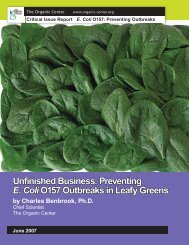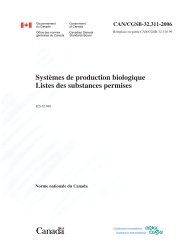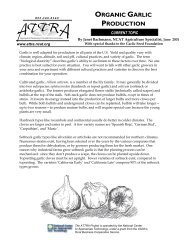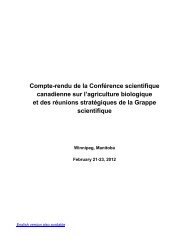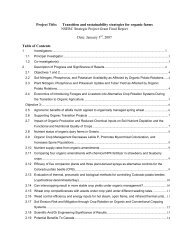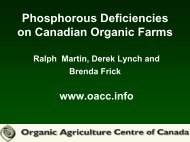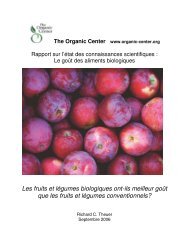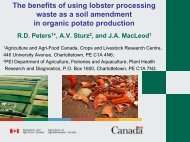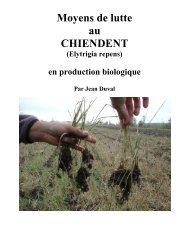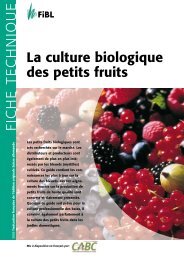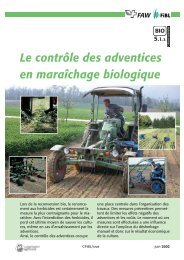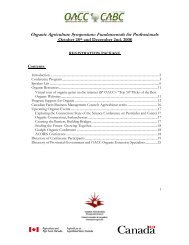Comparison of Organic and Conventional Cropping System from ...
Comparison of Organic and Conventional Cropping System from ...
Comparison of Organic and Conventional Cropping System from ...
Create successful ePaper yourself
Turn your PDF publications into a flip-book with our unique Google optimized e-Paper software.
<strong>Comparison</strong> <strong>of</strong> <strong>Organic</strong> <strong>and</strong> <strong>Conventional</strong><br />
<strong>Cropping</strong> <strong>System</strong> <strong>from</strong> Climate Change<br />
Perspective<br />
Tek B. Sapkota 1 , Daniele Antichi 1 , Paola Belloni 2 , Paolo Barberi 1<br />
<strong>and</strong> Marco Mazzoncini 2<br />
1<br />
Sant Anna’ School <strong>of</strong> Advanced Studies, Pisa<br />
2<br />
Center <strong>of</strong> Agro-environmental Research, University <strong>of</strong> Pisa
Agriculture as victim <strong>of</strong> climate change<br />
Climate change has many consequences on agricultural production <strong>and</strong><br />
productivity<br />
Drought<br />
Flood<br />
Pests outbreak<br />
Sea level rise
Agriculture is also one <strong>of</strong> the causes <strong>of</strong> climate change
How can agriculture be made more climate friendly?<br />
Optimum Agricultural Practices<br />
Less GHG<br />
emission<br />
Carbon<br />
sequestration
Mediterranean Arable <strong>System</strong> <strong>Comparison</strong> Trail (MASCOT)<br />
Hypothesis<br />
<strong>Organic</strong> agriculture is superior to its conventional counterpart economically,<br />
agronomically <strong>and</strong> environmentally<br />
Objectives <strong>of</strong> this paper<br />
• To evaluate <strong>and</strong> compare emissions <strong>of</strong> greenhouse gases <strong>from</strong> organic<br />
<strong>and</strong> conventional cropping systems<br />
• To compare energy efficiency <strong>of</strong> two cropping systems<br />
• To analyse total carbon balance <strong>and</strong> carbon sequestration potential <strong>of</strong><br />
two cropping systems.<br />
Where?<br />
•Centre for Agri-environmental Research "E. Avanzi" (CIRAA), Pisa, Italy
DURUM WHEAT<br />
SUGAR BEET<br />
<strong>System</strong> description<br />
Parallel comparison <strong>of</strong> <strong>Organic</strong> <strong>and</strong> <strong>Conventional</strong> Production system<br />
<strong>Organic</strong> <strong>Conventional</strong><br />
COMMON WHEAT<br />
PIGEON BEAN<br />
SUNFLOWER<br />
Vegetable strips <strong>and</strong> hedge row<br />
DURUM WHEAT<br />
SUGAR BEET<br />
COMMON WHEAT<br />
PIGEON BEAN<br />
SUNFLOWER<br />
Figure: Showing one replication <strong>of</strong> field layout
Aerial View <strong>of</strong> experimental site<br />
Ragnaino
Summary <strong>of</strong> Agronomic practices<br />
Cultural<br />
practice<br />
Sugar beet<br />
CS<br />
OS<br />
Common wheat<br />
CS<br />
OS<br />
Sunflower<br />
CS<br />
OS<br />
Pigeon bean<br />
CS<br />
OS<br />
Durum wheat<br />
CS<br />
OS<br />
Main tillage<br />
(depth cm)<br />
50<br />
25<br />
25<br />
25<br />
25<br />
25<br />
25<br />
50<br />
25<br />
Fertilisation<br />
Mineral<br />
<strong>Organic</strong><br />
Mineral<br />
<strong>Organic</strong><br />
Mineral<br />
<strong>Organic</strong><br />
Mineral<br />
None<br />
Mineral<br />
<strong>Organic</strong><br />
Fertilisation<br />
(kg ha -1 )<br />
162 N<br />
138 P 2<br />
O 5<br />
250 K 2<br />
O<br />
30 N<br />
30 P 2<br />
O 5<br />
30 K 2<br />
O<br />
156 N<br />
92 P 2<br />
O 5<br />
0 K 2<br />
O<br />
30 N<br />
30 P 2<br />
O 5<br />
30 K 2<br />
O<br />
128 N<br />
96 P 2<br />
O 5<br />
96 K 2<br />
O<br />
30 N<br />
30 P 2<br />
O 5<br />
30 K 2<br />
O<br />
0 N<br />
69 P 2<br />
O 5<br />
0 K 2<br />
O<br />
-<br />
156 N<br />
92 P 2<br />
O 5<br />
0 K 2<br />
O<br />
30 N<br />
30 P 2<br />
O 5<br />
30 K 2<br />
O<br />
Seed rate<br />
18<br />
seeds m -2<br />
18<br />
seeds m -2<br />
200<br />
kg ha -1<br />
200<br />
kg ha -1<br />
8<br />
seeds<br />
m -2<br />
8<br />
seeds<br />
m -2<br />
200<br />
kg ha -1<br />
200<br />
kg ha -1<br />
230<br />
kg ha -1<br />
230<br />
kg ha -1<br />
Weed<br />
control<br />
Pre-em +<br />
post-em<br />
-<br />
Post-em<br />
ST H<br />
Pre-em<br />
Hoeing<br />
None<br />
STH<br />
Post-em<br />
STH<br />
Residue<br />
managemen<br />
t<br />
Incorp.<br />
Incorp.<br />
Remove<br />
Incorp.<br />
Incorp.<br />
Incorp.<br />
Incorp.<br />
Incorp.<br />
Removed<br />
Incorp.
Results<br />
GHG emission<br />
CO2<br />
emission<br />
Fertilizer<br />
Pesticides<br />
Fossil fuel<br />
Total consumption <strong>of</strong> these resources ha -1 in each system was multiplied by the<br />
index <strong>of</strong> IPCC, American Petroleum Institute (for fossil fuel) <strong>and</strong> R lal, 2004 (for<br />
fertilizer <strong>and</strong> pesticides).
Emission…………<br />
Total GHGs emission<br />
(CO 2<br />
equivalent kg/ha)<br />
610<br />
kg/ha<br />
<strong>Organic</strong><br />
1293<br />
kg/ha<br />
conventional
Emission…………<br />
GHGs emission <strong>from</strong> two production systems<br />
2500<br />
Greenhouse gas emission (CO 2<br />
kg ha -1 )<br />
2000<br />
1500<br />
1000<br />
500<br />
0<br />
Sugarbeet<br />
Common<br />
w heat<br />
<strong>Organic</strong><br />
Sunflow er Pigeon Bean Durum<br />
Crops<br />
Wheat<br />
<strong>Conventional</strong><br />
<strong>System</strong><br />
Average
Emission…………<br />
GHGs emission <strong>from</strong> two production systems as influenced<br />
by different agricultural activities<br />
2500<br />
FERTILIZERS<br />
2000<br />
PESTICIDES<br />
1500<br />
1000<br />
500<br />
FUEL<br />
Greenhouse gas emission<br />
(Kg CO2 ha-1 )<br />
0<br />
SB ORG<br />
SB CONV<br />
CW ORG<br />
CW CONV<br />
SF ORG<br />
SF CONV<br />
PB ORG<br />
PB CONV<br />
DW ORG<br />
DW CONV<br />
SYS ORG<br />
SYS CONV<br />
Crops/Production system
Emission…………<br />
Contribution <strong>of</strong> different farm operations to total fuel consumption-based emission<br />
30<br />
Percentage<br />
25<br />
20<br />
15<br />
10<br />
<strong>Organic</strong><br />
<strong>Conventional</strong><br />
5<br />
0<br />
Tillage Weed control Fertilizer<br />
Farm Operations application<br />
Mechanical<br />
harvest<br />
Ditch making
Carbon yield<br />
1600<br />
1400<br />
Total Carbonic yield <strong>from</strong> two production systems<br />
Grain <strong>and</strong> residue yield<br />
Green manure yield<br />
Weed biomass<br />
Total C Yield (Kg /ha)<br />
1200<br />
1000<br />
800<br />
600<br />
400<br />
<strong>Organic</strong><br />
<strong>Conventional</strong><br />
200<br />
0<br />
Sugarbeet<br />
Common<br />
w heat<br />
Sunflow er<br />
Crops<br />
Pigeon<br />
Bean<br />
Durum<br />
Wheat<br />
<strong>System</strong><br />
Average
Carbon balance…………<br />
Contribution <strong>of</strong> different components in total Carbon Yield <strong>from</strong> two systems<br />
Weeds<br />
2%<br />
Green manure<br />
13%<br />
Weeds<br />
2%<br />
Crop Residues<br />
44%<br />
Crop yield<br />
47%<br />
Crop yield<br />
54%<br />
Crop Residues<br />
38%<br />
<strong>Conventional</strong><br />
<strong>Organic</strong>
Carbon balance<br />
CO2<br />
emission<br />
Crop<br />
Residues<br />
<strong>Organic</strong><br />
Manure<br />
Green<br />
Manure<br />
Weeds<br />
Fertilizer<br />
Pesticides<br />
Fossil fuel<br />
C input<br />
into the soil<br />
Crop Production <strong>System</strong>
Carbon balance…………<br />
Total Carbon sequestration (C q/ha)<br />
6<br />
Kg C/ha<br />
conventional<br />
344<br />
kg C/ha<br />
<strong>Organic</strong>
Carbon Balance…………<br />
Total Carbon Balance in soil <strong>from</strong> two cropping systems<br />
700<br />
600<br />
500<br />
<strong>Organic</strong><br />
<strong>Conventional</strong><br />
Total C balance (Kg C ha -1 )<br />
400<br />
300<br />
200<br />
100<br />
0<br />
-100<br />
-200<br />
-300<br />
Sugarbeet<br />
Common<br />
w heat<br />
Sunflow er<br />
Crops<br />
Pigeon<br />
Bean<br />
Durum<br />
Wheat<br />
<strong>System</strong><br />
Average<br />
• Positive value indicates sequestration <strong>of</strong> atmospheric carbon to soil<br />
• Negative value indicates loss <strong>of</strong> C <strong>from</strong> soil <strong>and</strong> subsequent release in<br />
atmosphere
Energy Balance<br />
Energetic index developed by Bonari et al, (1992)<br />
Input<br />
Oils<br />
Gasoil<br />
Oil<br />
Fertilizers<br />
N<br />
P<br />
K<br />
Pesticides<br />
Herbicides<br />
Insecticides<br />
Fungicides<br />
Seeds<br />
Wheat<br />
Sugarbeet<br />
Sunflower<br />
Pigeon bean<br />
Machine<br />
MJ/hr<br />
MJ/ha<br />
EI(MJ kg-1)<br />
44.4<br />
80<br />
75.3<br />
12.6<br />
9.6<br />
91.3<br />
52.7<br />
55.7<br />
17.2<br />
54<br />
25.5<br />
33.5<br />
Output<br />
Yields<br />
Wheat<br />
Sugar beet<br />
Sunflower<br />
Pigeon bean<br />
By-products<br />
Wheat<br />
Sugar beet<br />
Sunflower<br />
Pigeon bean<br />
EI (MJ kg-1)<br />
13.4<br />
2.90<br />
21.8<br />
16.7<br />
17.6<br />
11.7<br />
15.9<br />
15.9<br />
Wt <strong>of</strong> machine (kg) X energetic index (Mj/Kg)<br />
/life <strong>of</strong> machine (hrs)<br />
Hr/ha X MJ/hr
Energy Balance<br />
Energy input <strong>and</strong> output in two cropping systems<br />
Energy input (GJ ha -1 )<br />
30<br />
25<br />
20<br />
15<br />
10<br />
5<br />
<strong>Organic</strong><br />
<strong>Conventional</strong><br />
Energy output (GJ ha -1 )<br />
250<br />
200<br />
150<br />
100<br />
50<br />
<strong>Organic</strong><br />
<strong>Conventional</strong><br />
0<br />
Sugar beet Sunflow er Durum Wheat Common<br />
Crops<br />
Wheat<br />
Pigeon Bean<br />
<strong>System</strong><br />
Average<br />
0<br />
Sugar beet Sunflow er Durum Wheat Common<br />
Crops<br />
Wheat<br />
Pigeon Bean<br />
<strong>System</strong><br />
Average
Energy balance…………<br />
Energy consumed by various agricultural operations in two<br />
production systems<br />
30000<br />
Energy consumption (Mjha -1 )<br />
25000<br />
20000<br />
15000<br />
10000<br />
5000<br />
harvesting<br />
Pesticides<br />
Weed control<br />
Fertilization<br />
Soil tillage <strong>and</strong> sowing<br />
0<br />
<strong>Organic</strong><br />
<strong>Conventional</strong><br />
Production <strong>System</strong>
Energy balance…………<br />
Energetic Output Input Ratio<br />
Energy output/inpput ratio<br />
16<br />
14<br />
12<br />
10<br />
8<br />
6<br />
4<br />
2<br />
<strong>Organic</strong><br />
<strong>Conventional</strong><br />
0<br />
Sugar beet Sunflow er Durum Wheat Common<br />
Crops<br />
Wheat<br />
Pigeon Bean<br />
<strong>System</strong><br />
Average
Energy balance…………<br />
0.45<br />
Efficiency <strong>of</strong> energy use in two production system<br />
(Economic yield/energy input)<br />
Energy efficiency (Kg MJ -1 )<br />
0.40<br />
0.35<br />
0.30<br />
0.25<br />
0.20<br />
0.15<br />
0.10<br />
<strong>Organic</strong><br />
<strong>Conventional</strong><br />
0.05<br />
0.00<br />
Sugar beet Sunflower Durum Wheat Common<br />
Crops<br />
Wheat<br />
Pigeon Bean<br />
<strong>System</strong><br />
Average
Conclusion<br />
<strong>Organic</strong> production <strong>of</strong> arable crops under Mediterranean condition<br />
significantly contribute to mitigate climate change as compared with its<br />
conventional counterpart by:<br />
-emitting less CO 2 into the atmosphere<br />
-sequestering more C into the soil <strong>from</strong> atmosphere<br />
-by consuming less energy per unit area <strong>of</strong> farming
Thank you for you attention



